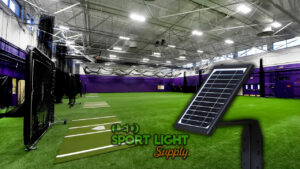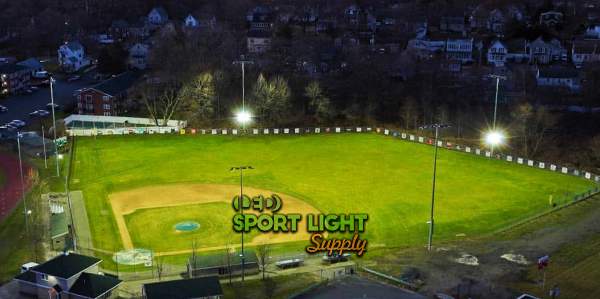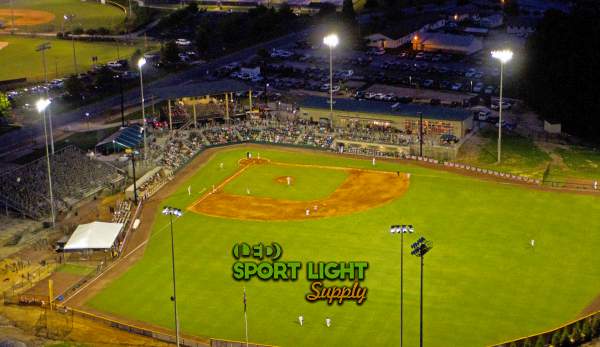
In recent years, the shift toward sustainable and energy-efficient solutions has transformed various sectors, including sports facilities. Solar-powered LED lighting systems are emerging as a powerful alternative for baseball field lighting, merging energy efficiency with environmental benefits. With their ability to reduce operational costs, provide high-quality illumination, and integrate with advanced technology, these lighting systems present an attractive option for field operators seeking both sustainability and cost savings.
Table of Contents
Toggle LED technology has long been recognized for its energy-saving capabilities. Compared to traditional lighting options, LEDs require significantly less energy to produce the same or better quality of light. This lower power consumption translates directly into reduced electricity usage, making LEDs an energy-efficient choice for illuminating large spaces like baseball fields. The longevity of LEDs also means that they need fewer replacements, offering an additional advantage over conventional lights. This durability decreases the frequency of maintenance, further cutting down operational costs.
LED technology has long been recognized for its energy-saving capabilities. Compared to traditional lighting options, LEDs require significantly less energy to produce the same or better quality of light. This lower power consumption translates directly into reduced electricity usage, making LEDs an energy-efficient choice for illuminating large spaces like baseball fields. The longevity of LEDs also means that they need fewer replacements, offering an additional advantage over conventional lights. This durability decreases the frequency of maintenance, further cutting down operational costs.
When LED lighting is powered by solar energy, the financial benefits become even more pronounced. Solar-powered systems utilize the sun’s abundant energy, reducing reliance on grid electricity and significantly lowering monthly utility bills. Though the initial investment in solar panels may seem high, it is gradually offset by the cost savings realized through the reduced use of traditional energy sources. Over time, baseball field operators can see substantial financial benefits, turning the initial investment into a long-term asset that supports operational savings. The combination of solar energy and LED lighting is therefore not only a sustainable choice but also a financially sound decision for sports facilities.
One of the most substantial environmental advantages of solar-powered LED lighting is its reliance on clean, renewable energy. Solar power produces zero emissions during operation, unlike traditional energy sources that rely on fossil fuels and contribute to greenhouse gas emissions. By adopting solar power for field lighting, baseball fields can contribute to lower carbon footprints, supporting global efforts to combat climate change. Reducing dependency on fossil-fuel-powered electricity aligns with sustainability goals and encourages a more eco-conscious approach to sports facility management.
In addition to the benefits of solar energy, LEDs themselves present an environmentally friendly alternative to traditional lighting. Many conventional lighting solutions contain hazardous materials, such as mercury, which can be harmful to the environment when disposed of improperly. LEDs are free from such toxic substances, further enhancing their eco-friendliness. This feature not only benefits the environment but also aligns with stricter regulations on waste management and disposal, making LEDs a responsible choice for facilities looking to reduce their environmental impact.
 Illumination quality is a key consideration for sports fields, where adequate lighting plays a crucial role in ensuring visibility and safety. LED lights offer a distinct advantage over traditional lighting by providing consistent and uniform brightness across the entire field. Unlike older lighting systems that may create uneven lighting patterns and shadows, LED lights deliver a high level of clarity that enhances visibility for players, referees, and spectators alike. This consistency in brightness contributes to a better game experience, allowing athletes to perform at their best and audiences to enjoy the game without visual distractions.
Illumination quality is a key consideration for sports fields, where adequate lighting plays a crucial role in ensuring visibility and safety. LED lights offer a distinct advantage over traditional lighting by providing consistent and uniform brightness across the entire field. Unlike older lighting systems that may create uneven lighting patterns and shadows, LED lights deliver a high level of clarity that enhances visibility for players, referees, and spectators alike. This consistency in brightness contributes to a better game experience, allowing athletes to perform at their best and audiences to enjoy the game without visual distractions.
Another notable benefit of LED lighting is its ability to minimize glare, a common issue with traditional lighting solutions. Glare reduction is essential for creating a comfortable viewing experience, especially for spectators in the stands and players on the field. By reducing shadows and glare, LED systems enhance visual accuracy and clarity, making them an ideal lighting choice for sports fields where high-intensity activities require precise and clear lighting conditions. This quality is particularly valuable during night games, where consistent lighting helps maintain the integrity of the game.
LED technology stands out for its flexibility, allowing field operators to adjust lighting levels to suit specific needs. Solar-powered LED lighting systems offer adjustable brightness settings, enabling the customization of light intensity based on the time of day, weather conditions, or event requirements. Whether the field is hosting a daytime practice session or a high-energy night game, operators can tailor the lighting to enhance both visibility and ambiance. This adaptability provides significant advantages, ensuring that lighting conditions are optimized for the event and contributing to a better experience for all participants.
Beyond adjustable brightness, solar-powered LED systems also offer customizable lighting patterns. This feature is particularly valuable for fields with various lighting requirements based on different sports or events. Operators can design lighting configurations that focus on specific areas of the field or create patterns that reduce energy use when full-field illumination is unnecessary. The ability to tailor lighting to suit specific needs not only enhances performance on the field but also helps conserve energy, reinforcing the sustainability of solar-powered LED systems.
Installing solar-powered LED lighting systems is typically a straightforward process that requires minimal disruption to field operations. Unlike traditional lighting setups, which often require extensive wiring and groundwork, solar-powered systems can be installed with minimal interference. Solar panels are usually mounted on poles or nearby structures, while LED fixtures are strategically placed to provide optimal field coverage. This setup simplifies the installation process, allowing for quick and efficient setup without prolonged downtime.
Solar-powered LED systems are designed with durability and low-maintenance needs in mind. LEDs, in particular, are known for their long operational lifespan, often lasting up to 150,000 hours before needing replacement. This durability reduces the frequency of bulb changes, allowing field operators to focus on other aspects of facility management. Additionally, solar panels are built to withstand various weather conditions, from rain to extreme heat, ensuring that the system remains reliable throughout the year. The low-maintenance nature of solar-powered LED lighting not only reduces operational costs but also provides peace of mind for field managers who seek a dependable, long-lasting lighting solution.
One of the standout characteristics of LED lighting is its impressive lifespan, which often exceeds that of traditional bulbs by a significant margin. LEDs can last several years without requiring replacement, making them a practical choice for sports fields that require consistent, high-quality lighting. This longevity is complemented by the durability of solar panels, which are built to handle harsh environmental conditions. The extended lifespan of both LEDs and solar panels ensures that baseball fields can benefit from consistent lighting without frequent interruptions or replacements.
Solar-powered LED lighting systems are crafted to endure a variety of weather conditions, from intense sunlight to heavy rainfall and wind. This resilience makes them a reliable choice for outdoor installations, providing dependable lighting that withstands the elements. By investing in a system that can perform consistently in diverse climates, baseball field operators can ensure that lighting quality remains uninterrupted, even during adverse weather. This durability is a testament to the engineering of solar-powered LED systems, making them a wise investment for long-term use.
With ongoing advancements in solar technology, solar panels are becoming increasingly efficient, capturing and converting more sunlight into usable energy. These improvements enhance the overall performance of solar-powered LED systems, allowing them to produce brighter lighting with less energy. As solar panels become more effective, baseball field operators can expect even greater returns on their investment, as newer panels require less space and generate more power.
Advancements in energy storage technology also play a crucial role in the effectiveness of solar-powered LED lighting. Modern energy storage solutions, such as lithium-ion batteries, allow systems to store excess solar energy generated during the day for use at night or during cloudy weather. This capability ensures that the lighting system remains operational regardless of sunlight availability, providing consistent performance and eliminating concerns about fluctuating power levels. Improved energy storage adds a layer of reliability that complements the flexibility of solar-powered LED systems.
The future of baseball field lighting is moving towards increased integration with smart systems, which offer sophisticated monitoring and control features. Smart lighting solutions enable real-time monitoring of lighting conditions, allowing adjustments based on factors such as weather, time of day, and field usage. This level of automation helps optimize lighting performance while maximizing energy savings, creating an efficient system that adapts to changing conditions.
Smart systems also provide data-driven insights that enable field operators to make informed decisions about lighting management. By analyzing usage patterns, energy consumption, and other metrics, operators can adjust lighting schedules and intensity levels to match demand, further enhancing energy efficiency. This automated approach to lighting control ensures that solar-powered LED systems operate at peak performance, offering both cost savings and an enhanced experience for players and spectators.
The adoption of solar-powered LED lighting systems offers a transformative solution for baseball fields, combining sustainability, efficiency, and advanced technology. From reducing energy costs to providing high-quality illumination and supporting environmental goals, these systems represent a forward-thinking approach to field management. As technology continues to evolve, solar-powered LED lighting promises to deliver even greater benefits, making it an ideal choice for modern sports facilities. Baseball field operators who embrace this innovation are not only enhancing the field experience but also contributing to a more sustainable future in sports.
The shift to solar-powered LED lighting is shaping a sustainable future for baseball fields by merging energy efficiency with environmental responsibility. These systems offer substantial benefits, from lower operational costs and reduced maintenance to superior illumination quality that enhances both gameplay and spectator experience. With advancements in solar technology and the integration of smart systems, solar-powered LED lighting provides a forward-looking solution that supports environmental goals while meeting the dynamic needs of sports facilities. Embracing this innovation empowers baseball field operators to create a high-quality, eco-friendly environment, fostering a commitment to sustainability within the sports industry.
Drop us a line to receive a free lighting design